Growing up most people have a board game that they really enjoyed playing as a kid. As you grow older though most of these games don’t live up to your memories of them. Today I am looking at one of those games from my childhood, Payday. Payday probably wasn’t my favorite game growing up but I would have to say that it is one of the games I remember playing most. There was something about the game that I really enjoyed. As most of the games from my childhood don’t tend to stand up well to this day, I was a little worried that Payday would be another game that didn’t live up to my memories of the game. While Payday is a pretty generic roll and move game that relies on a lot of luck, there is just something about the game that makes it stand out among most roll and move games.
How to Play Payday
These rules are for the 1975 version of the game. The additional/changed rules for the 1994 version of the game are at the bottom of the how to play section.
Setup
- The players need to decide on how many months they are going to play.
- Shuffle the mail and deal cards separately and place them near the board.
- Each player chooses a playing piece and places it on the start space.
- Each player is given $325.
- The players choose who will start the game.
Playing the Game
On a player’s turn they roll the die and move their playing piece the corresponding number of spaces. Depending on what space the player lands on they will take a specified action. After a player has taken the action corresponding to the space they landed on, their turn ends and play passes to the next player clockwise.
Mailbox
If a player lands on a mailbox space they will draw a number of mail cards equal to the number on the mailbox.
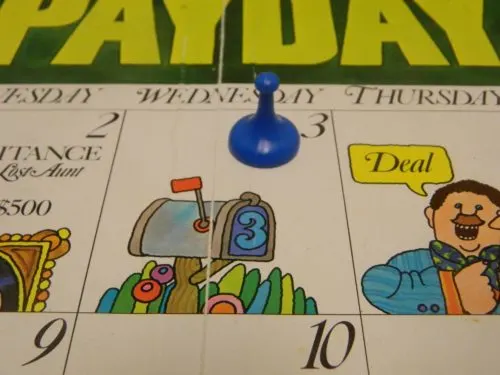
This player has landed on a mailbox space. They will have to draw the top three cards from the mail pile.
Players will take different actions depending on what mail cards they draw.
- Advertisements and post cards are discarded immediately.
- Insurance cards must either be purchased immediately or discarded. When a player purchases a piece of insurance they keep it front of them for the rest of the game and any bills associated with the insurance purchased are immediately discarded.
- Bill cards are kept by the player until they reach their next pay day.
- Lottery tickets are kept by the player until the end of the month. If a player lands on the “lottery draw” space during the month, the player receives the money from all of their lottery tickets from the bank. If they reach the end of the month and didn’t land on a lottery space, the player discards all of their lottery tickets.
- Swellfare cards can only be used if a player’s debt, loan interest and bills are higher than the amount of cash they have on hand. If a player qualifies they can bet up to $100 and then they roll the die. If they roll a five or six they receive ten times what they bet from the bank. If they roll any other numbers the money they bet goes into the pot. The swellfare card is then discarded.
Deal
When a player lands on a deal space they take the top card from the deal deck. They look at the deal card and decide whether they would like to purchase the card. If they choose to purchase the card they pay the bank the amount listed on the card and they get to keep the card. When a player purchases a deal card all of the players roll the die once and whichever player rolls the highest number gets the commission amount from the bank. If the player chooses not to purchase the card they put it on the bottom of the stack of deal cards.
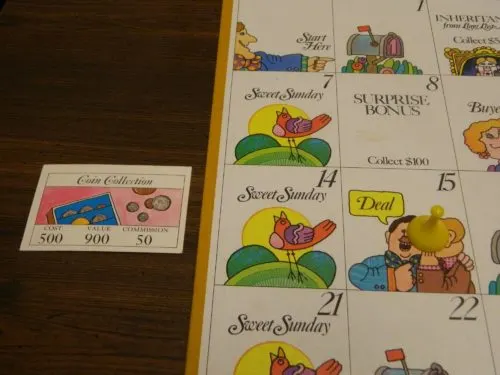
The yellow player has landed on a deal space and has decided to purchase the coin collection for $500.
Buyer
When a player lands on a buyer space they have the opportunity to sell one of the deal cards they purchased on a previous turn. The player can choose one of their deal cards and sell it for the “value” amount. The bank pays them the associated amount of money and the deal card is placed on the bottom of the deal deck.
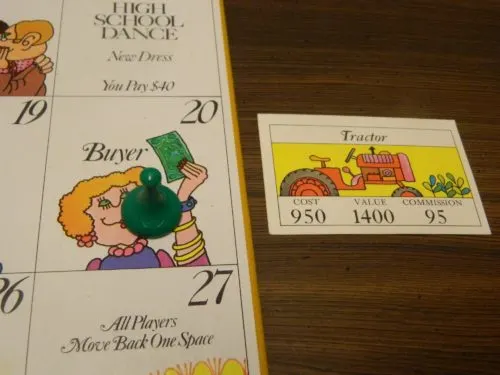
The green player had purchased the tractor on a previous turn. They now have landed on a buyer space so they can sell it for $1,400.
Daylight Savings Time
When a player lands on the Daylight Savings space all players will move back one space. The player who landed on the space moves back one space first and takes the action on the space they were moved to. Then each player in clockwise order moves their piece back one space and takes the corresponding action. If a player is on the first of the month before moving back they will collect another $325 but will stay on the first of the month space.
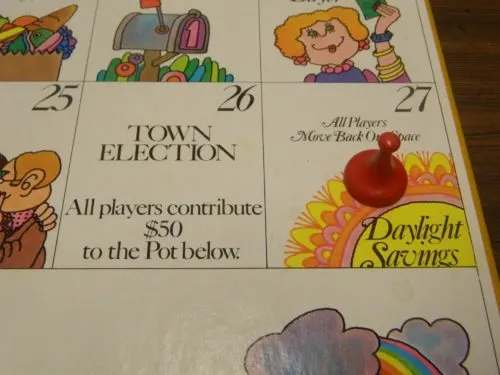
The red player has landed on the Daylight Savings space so all of the players will move back one space. The red player will move back to the town election space so everyone will have to contribute $50 to the pot.
Town Election
Everyone must contribute $50 to the pot. The next player that rolls a six during the game will get to take all of the money from the pot.
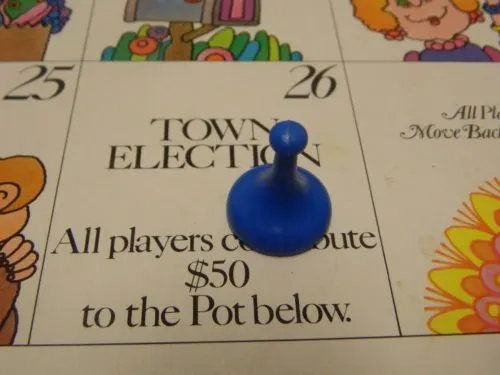
The blue player has landed on the town election space. All of the players have to pay $50 to the pot.
Poker Game
Each player has the option of playing the poker game. Each player that wants to play puts in $100 and each player rolls the die. Whoever rolls the highest number wins all of the money that was bet.
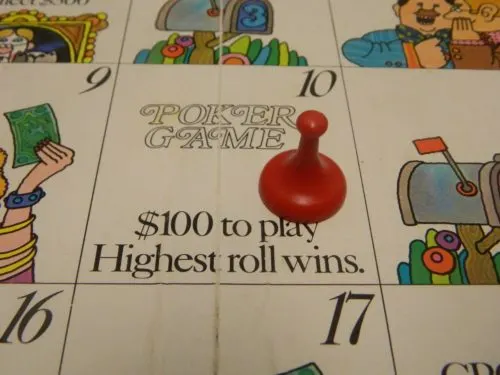
The red player has landed on the poker game space. All of the players need to choose whether they would like to play in the poker game.
Savings and Loans
Throughout the game players might either want or need to take out a loan or put money into savings. During the game a player may only have savings or a loan but not both.
When a player takes out a loan, the loan is recorded and the player receives the amount of the loan from the bank. When taking out a loan, all loans must be in increments of $100. On pay day a player has to pay 20% interest on the amount of money they borrowed. A player can only pay off all or part of their loan on pay day.
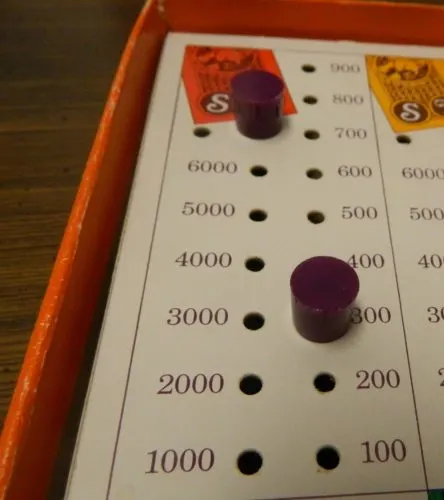
The red player has taken out a $300 loan. At the end of the month they will have to pay $60 in interest.
When a player puts money into their savings, they pay the money to the bank and the amount is recorded. All money put into savings must be in $100 increments. Players can only add money to a savings account on pay day. On pay day a player can take out as much money as they want out of their savings but if they take out money on any other day they are charged a $50 fine. On pay day a player will receive 10% interest on all money they have in savings.
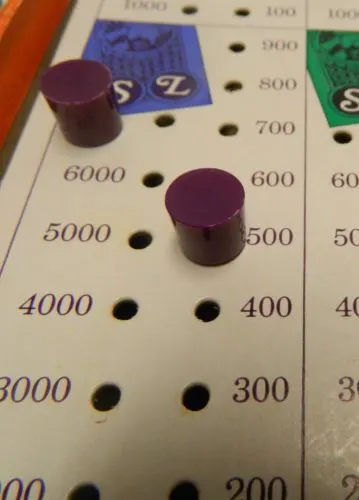
The blue player has put $500 into their savings. At the end of the month they will receive $50 in interest.
Pay Day
When a player reaches the pay day space they will stop moving even if they still had moves remaining.
Players will then follow these steps:
- Players receive $325 from the bank.
- Players will receive 10% interest on their money in savings or will have to pay 20% interest on their debt.
- Players count up all of the bills they acquired during the month and pay them off. All of the bills are then discarded. Players also discard all unused lottery tickets.
- Players have the option of paying off part or all of their loan. Player can also take money out of savings or add more money to their savings.
- The player moves their piece to the first of the month and will begin a new month on their next turn as long as they have not already completed the agreed upon number of months.
End of Game
When a player has completed the agreed upon number of months, the player’s game ends. Any unused deal cards are discarded and the player receives no money for the cards. Once all of the players have finished their final month, each player counts up their money in hand and in savings. If a player still has an outstanding loan they must pay it off. Everyone then compares their wealth. Whoever has the most money or is the least in debt (if everyone is in debt), wins the game.
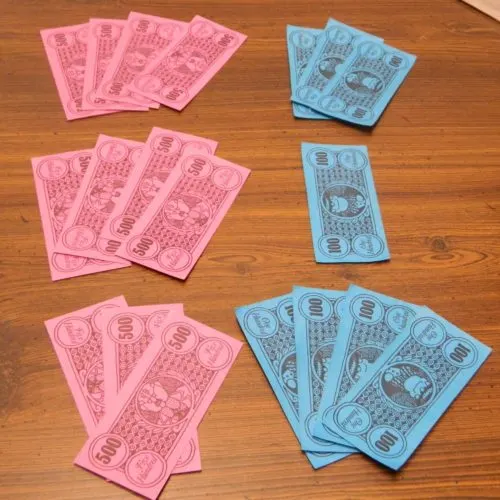
The top player has earned $2,300 in the game while the middle player has $2,100 and the bottom player has $1,900. The top player has the most money so they will win the game.
Additional Rules for 1994 version
Here are the additional/alternate rules from the 1994 version of Pay Day.
- Players receive $3,500 instead of $325 at the beginning of the game and each pay day.
- Loans have to be in $1,000 increments and there is no savings. All loan interest is 10% instead of 20%.
- When a deal card is purchased no commission is given out.
- If a player rolls a six during the game they take all of the money from the jackpot space.
Cards
- Pay A Neighbor: The player who draws the card must pay another player (of their choice) the amount listed on the card.
- Mad Money: The player who draws the card collects the amount of money on the card from the player of their choice.
- Charity: The player who draws the card pays the amount to the jackpot space.
- Monster Charge: Monster charge cards are kept until the end of the month. If the player wants to pay off the entire amount they pay the charges and the interest but are then able to get rid of the card. If they don’t want to pay the whole amount they pay the interest and keep the card for the next month.
- Deal/Buyer: The player can move to the next deal or buyer space.
Spaces
- Sweepstakes: Collect $5,000 from the bank.
- Lottery: The bank puts in $1,000 and all of the players have the option of putting in $100. Every player who put in $100 gets to chose a different number between 1 and 6. The player who lands on the space rolls the die. The player who picked the number that is rolled takes all of the money put in. If no one picked the number that is rolled, the die is rolled until a number that was picked is rolled.
- Super Ski Sunday, Charity Concert, Food For the Month, Shopping Spree: Pay the appropriate amount of money to the jackpot spot on the board.
- Radio Phone-In Contest: Starting with the player who landed on the spot, each player takes turns rolling the die. The first player to roll a three gets $1,000 from the bank.
- Happy Birthday: Every other player pays the player who landed on the space $100.
- Yard Sale: The player rolls the die and pays the bank $100 times the number they rolled. The player then takes the deal card that was placed on the yard sale space. A new deal card is then placed on the yard sale space.
- Walk for Charity: All players but the player who landed on the space roll the die and pay $100 times what they rolled to the jackpot spot.
My Thoughts on Payday
Like a lot of 1970s Parker Brothers games it should not surprise anyone that Payday is at its core a roll and move game. Prior to the mid 1990s and 2000s a lot of the board games released by major board game publishers were simple roll and move games. Like most of these games in Payday you basically roll the die and move your playing piece around the gameboard. The goal in Payday is to make enough money during the month in order to pay off your bills at the end of the month and still have some money left over to build up your wealth. Basically if you have ever played a roll and move game before you should have a good idea of what Payday plays like.
Like most roll and move games you don’t have a lot of impactful decisions in Payday. I think the biggest impact you can have on your own fate in the game involves the deal cards. While you have no control over landing on the spaces to purchase and sell them, the deal cards are likely going to be the deciding factor in most games of Payday. The deal cards are so important because they are the easiest way to make larger sums of money in the game. While some deal cards are much better than others, you can earn hundreds to thousands of dollars for each card that you are able to buy and sell. There are few other opportunities in the game where you can make even close to that much money.
While you can make a lot of money from deal cards, you have to make the right choices on when to purchase and when to pass on deal cards. While you will make money on every deal card if you are able to sell it, some deal cards are better than others. If you don’t have a lot of money you might choose to pass on a deal card that doesn’t give you a great return on your money hoping to get a better value on your next deal card. There is also the fact that if you don’t sell a deal card by the end of the game you get nothing for it. This forces players to decide what deal cards are worth purchasing and which they should pass on. This is where most of the decision making in Payday comes from.
Other than the deal cards there are a couple other small opportunities to make decisions in Payday. Insurance gives players a chance to eliminate some of the risk in the game. If you get the opportunity to buy insurance early in the game it is worth purchasing if you think you will get a lot of bills associated with the insurance. Towards the end of the game though insurance loses most of its value as you likely won’t get much use out of it before the end of the game. As far as loans you will occasionally have to decide whether it is worth it to take out a loan in order to purchase a deal card. Twenty percent interest is pretty high but you can make a lot more than that if you are able to sell off the deal card quickly. As far as savings you need to figure out the right amount to deposit. Ten percent interest is not a lot but it adds up if you have a lot of money in savings. You need to be careful not to put too much into savings though since you don’t want to have to take out money during the month and pay a $50 penalty.
While it only adds luck to the game, for some reason I think my favorite mechanic in Payday has always been the mail mechanic. I have always liked the mail mechanic because it is fun drawing mail cards hoping not to get a bill. The mechanic is basically just another way to add luck into the game but I like how it adds to the theme of the game. The theme is helped by the “junk mail” cards that serve no real purpose in the game other than being filler that doesn’t do anything for the player who draws it.
While on the topic of the theme, I have to say that Payday kind of has a weird theme. Basically the theme of Payday is everyday life. The game simulates a typical month for an average person with ups and downs as you try to make enough money to pay off your bills. Now a lot of people think the theme of Payday is kind of stupid and I can see where they are coming from. Who wants to play a board game that simulates something that you do everyday in your normal life? I think the theme is kind of intriguing though as you don’t see many other board games tackling such mundane topics. Another reason that I like the theme is that I think it does a good job teaching children about life as an adult and basic money management concepts.
Another thing that I like about Payday is that the game has a pretty flexible length. Basically you can make the game as long as you want based on how many months you choose to play. The game recommends playing two or three months which is estimated to take around an hour. I don’t really agree with the game’s estimate though. First I wouldn’t recommend playing only two months as very little is going to happen in such a short amount of time. Second I think the game overestimates how long each month takes. We were able to play five months in an hour so I don’t know where the game’s estimate of three months per hour comes from.
Despite these positives and having fond memories of the game as a child, I will admit that Payday has most of the problems of every other generic roll and move game. The luckiest player is almost always going to win the game. There are some decisions that you have to make throughout the game but they usually are pretty obvious and don’t have a huge impact on whether a player wins or loses the game. The game does some things that you don’t see in other roll and move games but it still plays a lot like your typical roll and move game. It is probably one of the better pure roll and move games that I have played but at its core it is still a pretty generic roll and move game.
While not the most popular board game, Payday has been popular enough that it has been re-printed a couple times over the years. Usually when a board game gets re-printed there aren’t many changes to the actual gameplay. Usually the game is just updated to reflect the current time period and there might be a few tweaks to the rules in order to fix some issues with the game. Some games do have some more substantial changes made to them though as the publisher thinks they can improve upon the original game. Payday is one of those games as the newer versions of the game seem to have made a decent amount of changes to the original game. Here are just some of the difference I noticed between the 1975 and 1994 editions of the game.
- Not surprisingly the values in the game have been increased to reflect more recent times. Players are paid more each month, receive more money from positive events, and also pay more for bills and other expenses. While the bills are more expensive they don’t seem to have increased as much as your income which makes it easier to accumulate wealth in the 1994 version of the game.
- For some reason the 1994 version of the game decided to eliminate savings entirely. While you couldn’t really earn a lot from savings in the 1975 edition, I think it is a mistake not even giving the players an opportunity to earn interest off the money they aren’t using. Without savings you don’t have a lot to do with the money you accumulate throughout the game. Giving players 10% interest at the end of every month is not so complicated that it had to be eliminated.
- In addition to eliminating savings, loan interest was reduced from 20% to 10%. I don’t have that big of issue with this since 20% is too big of punishment for having to take out a loan in my opinion.
- The 1994 edition seems to have less emphasis on the mail cards since there are less of them. More of the mail cards also seem to have positive effects which makes drawing mail cards not as bad as in the original game. The game also got rid of the junk mail cards which I have always kind of liked.
- The 1994 version of the game seems to have a lot more redistribution of wealth in it. In the 1975 edition you would mostly either take money from the bank or pay money to the bank. The 1994 version has a greater emphasis on taking or giving money to the other players.
- The 1994 version of the game includes the yard sale mechanic which allows you to purchase a deal card for a lot less than you would otherwise have to pay. I think this mechanic adds even more luck to a game that already relies pretty heavily on luck.
- The final major addition to the 1994 version of the game seems to be the idea of the jackpot. The jackpot seems to add a lot of luck as quite a bit of the money you end up paying goes into the jackpot and the first player to roll a six gets all of that money.
This might be somewhat biased since I played the 1975 version of the game when I was a kid but I think the 1975 version of Payday is significantly better than the 1994 version of the game. Maybe the newer versions reversed some of the changes from the 1994 version but I just think the original version was structured better. As I already discussed one of the interesting things about Payday is that it is supposed to represent a normal person’s life from paycheck to paycheck. The biggest problem with the 1994 version of the game is that the month to month struggle has basically been eliminated from the game. While you eventually start to accumulate wealth in the 1975 version of the game, it is usually pretty slow and for your first couple of months you are fighting against having to borrow money. In the newer version of the game you should be able to accumulate money really quickly which basically eliminates this whole aspect of the game. Add in the 1994 version eliminating some of the more charming aspects of the original game and I think Payday is an example of one of those games where the original version is better than the newer versions.
Being an older Parker Brothers game I have to say that there really isn’t anything particularly special about the components of Payday. Basically you get what you would expect out of a 1970s Parker Brothers game. You get a decent amount of cards. The gameboard and other components have pretty generic artwork. The artwork from the 1975 version of the game might appeal to people who like the look of older board games but this is one area where I think the newer versions of the game might actually be better. The newer versions don’t have great artwork either but the components just look nicer in my opinion.
Should You Buy Payday?
Payday is one of those older board games that don’t get a lot of love. I can actually see why a lot of people don’t like the game as at its core Payday is a basic roll and move game that relies heavily on luck. I can also see people not wanting to play a game about paying bills. I have fond memories of the game from childhood though and I don’t think the game is as bad as some people make it out to be. While the game doesn’t have a lot of decision making, neither does most pure roll and move games. I think Payday has a lot of charm for a 1970s board game. While Payday is far from a great game, I think it is a solid game and probably one of the best pure roll and move games.
If you don’t really like roll and move games and don’t have fond memories of Payday you aren’t going to like the game. If you like roll and move games though and/or have fond memories for Payday, I think it is worth playing. I would probably recommend picking up the 1975 version of the game though as in my opinion it is better than the newer versions of the game.
If you would like to purchase Payday you can find the game online: Payday (1975) on Amazon, Payday (1994) on Amazon
, eBay

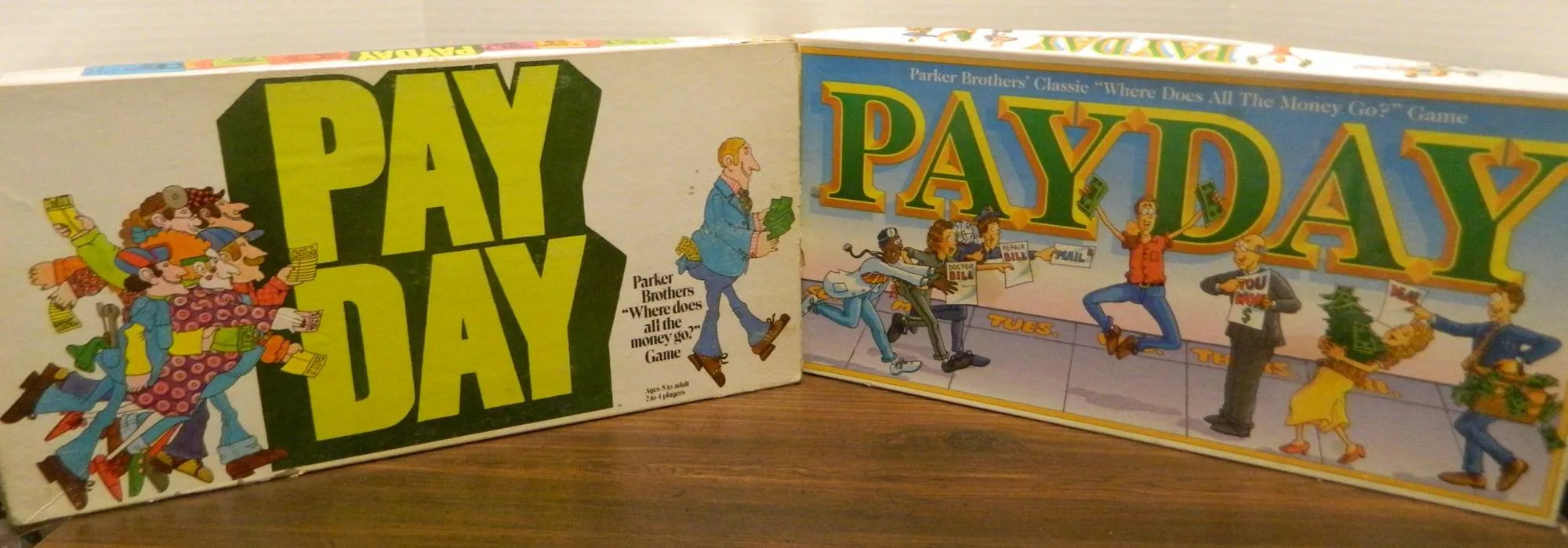
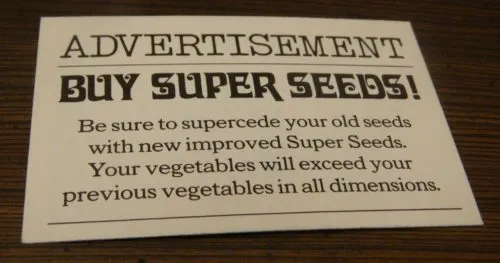
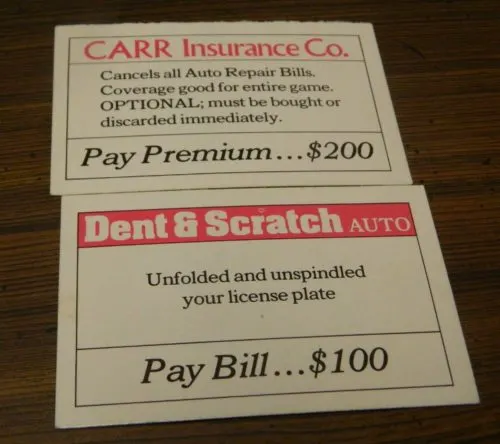
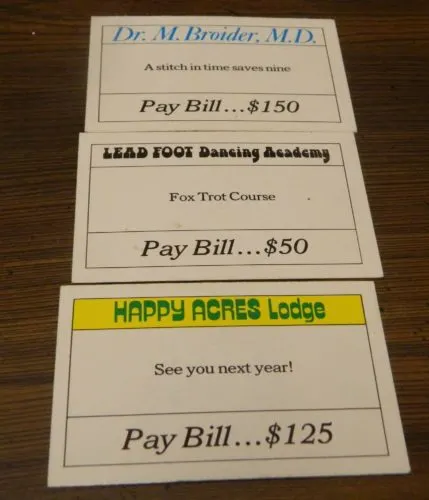
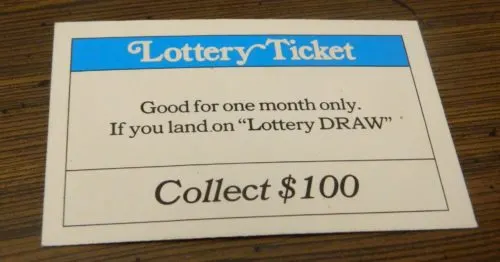
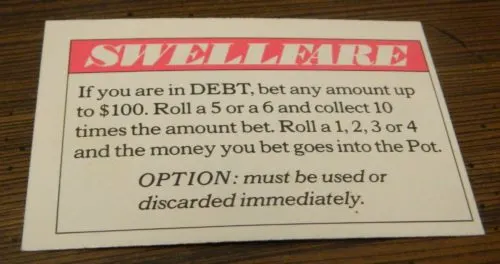
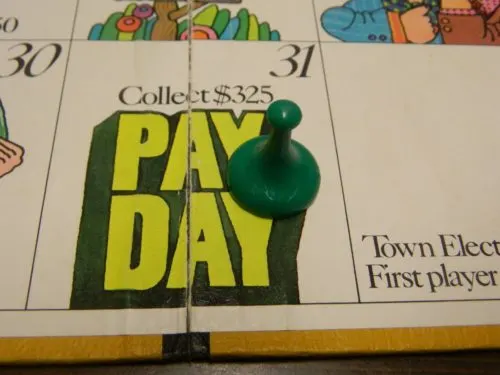
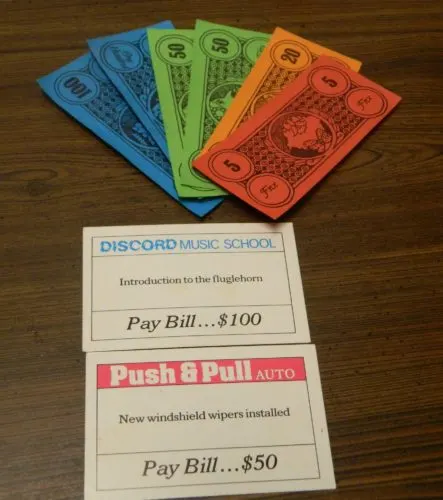
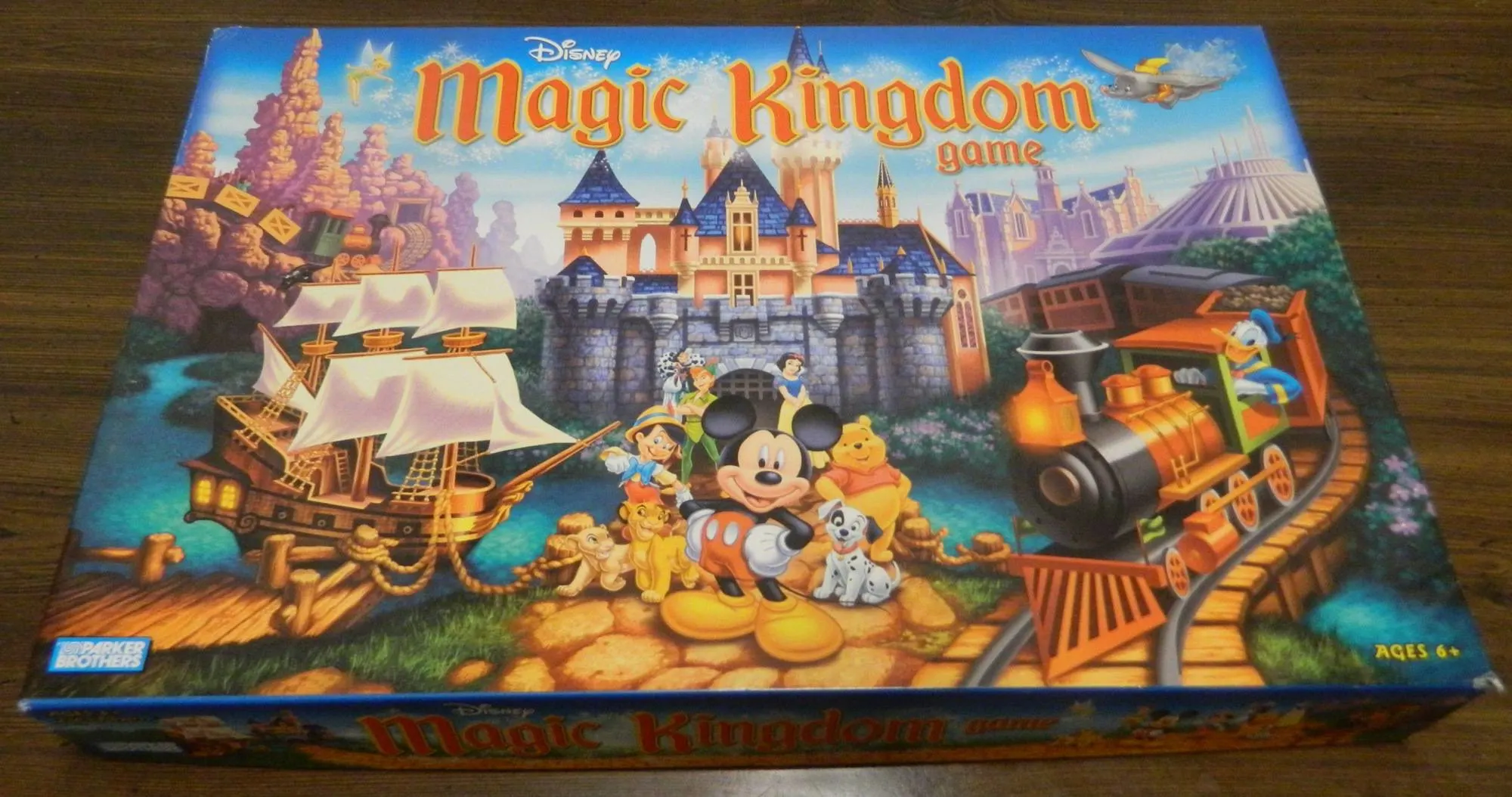
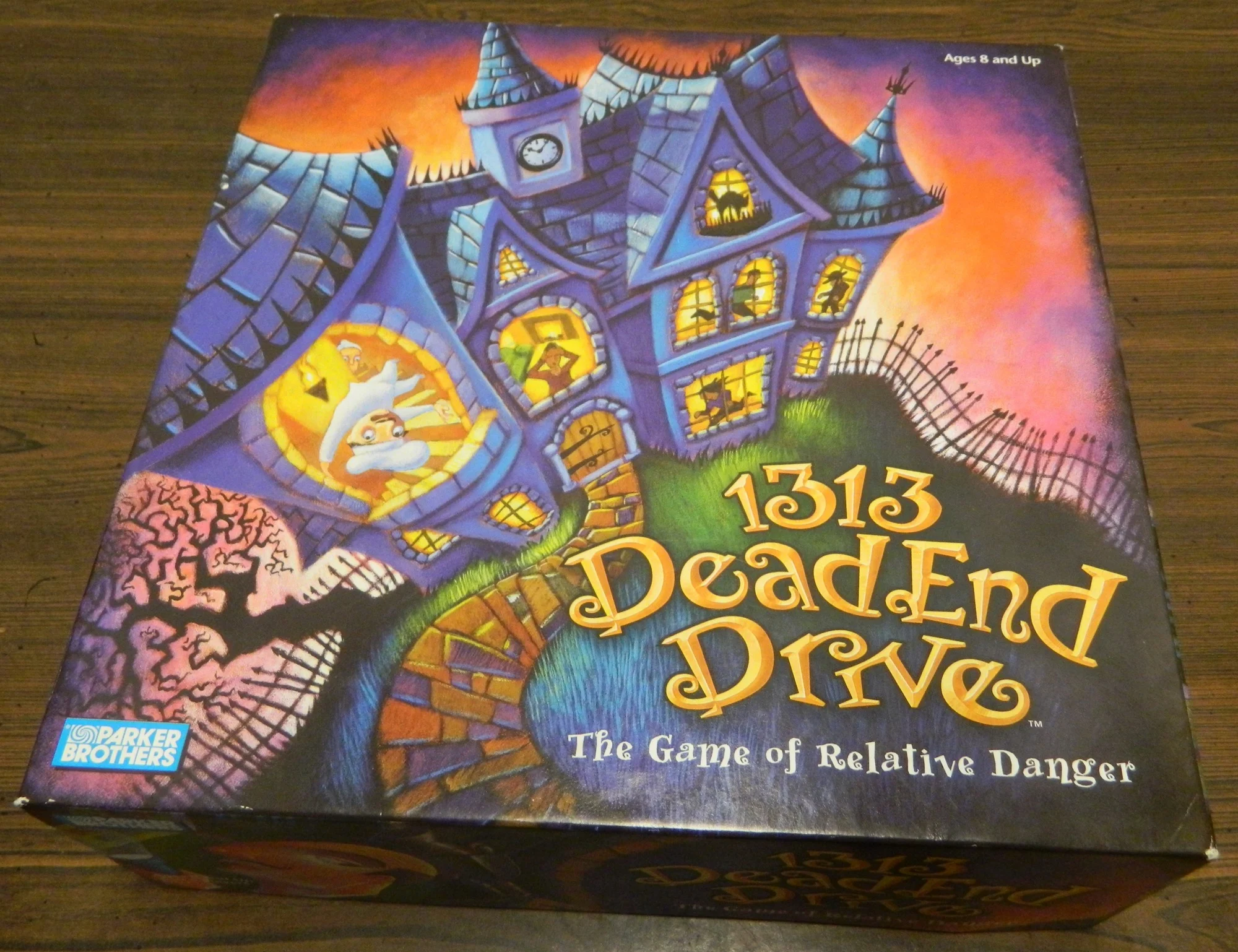
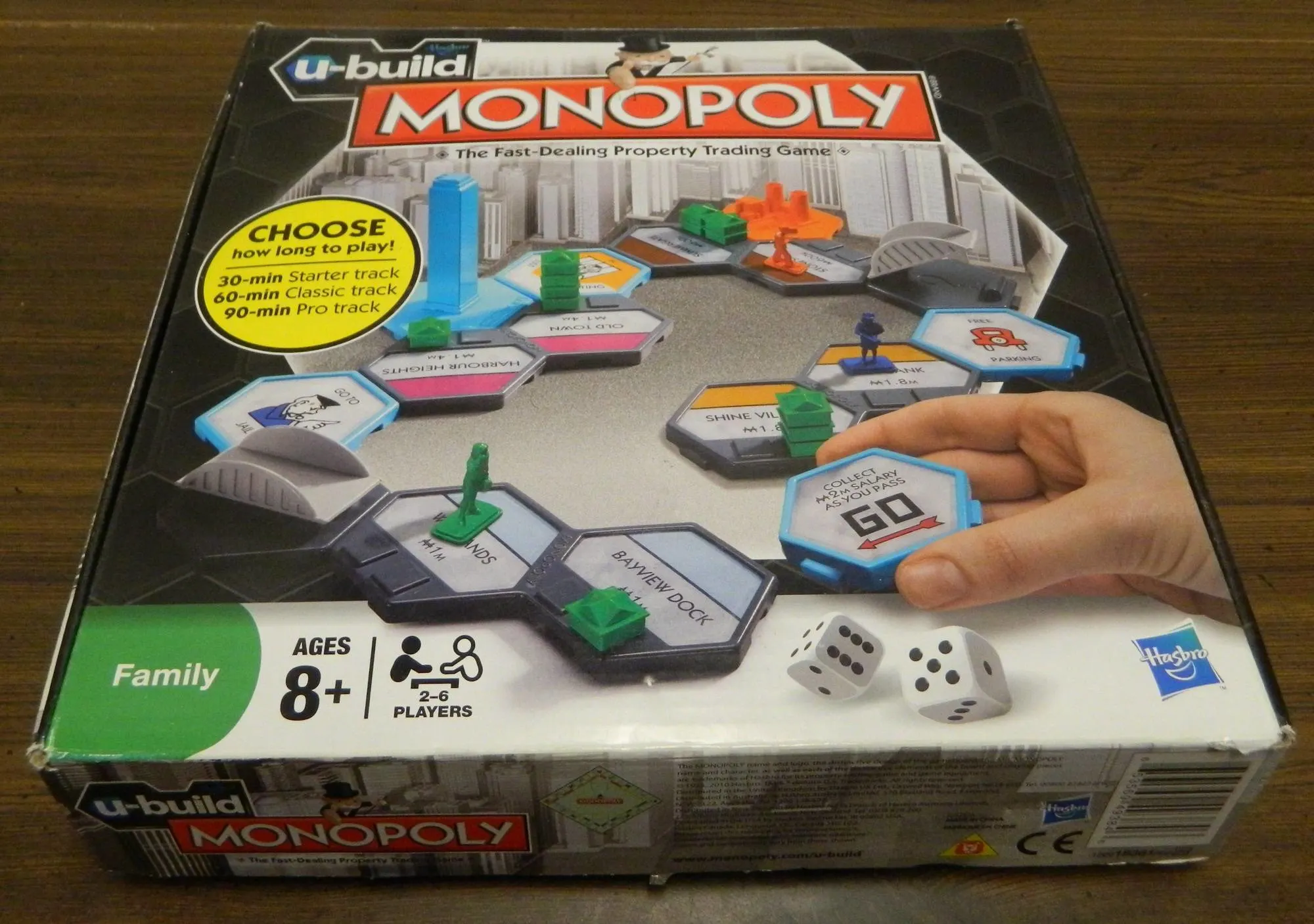
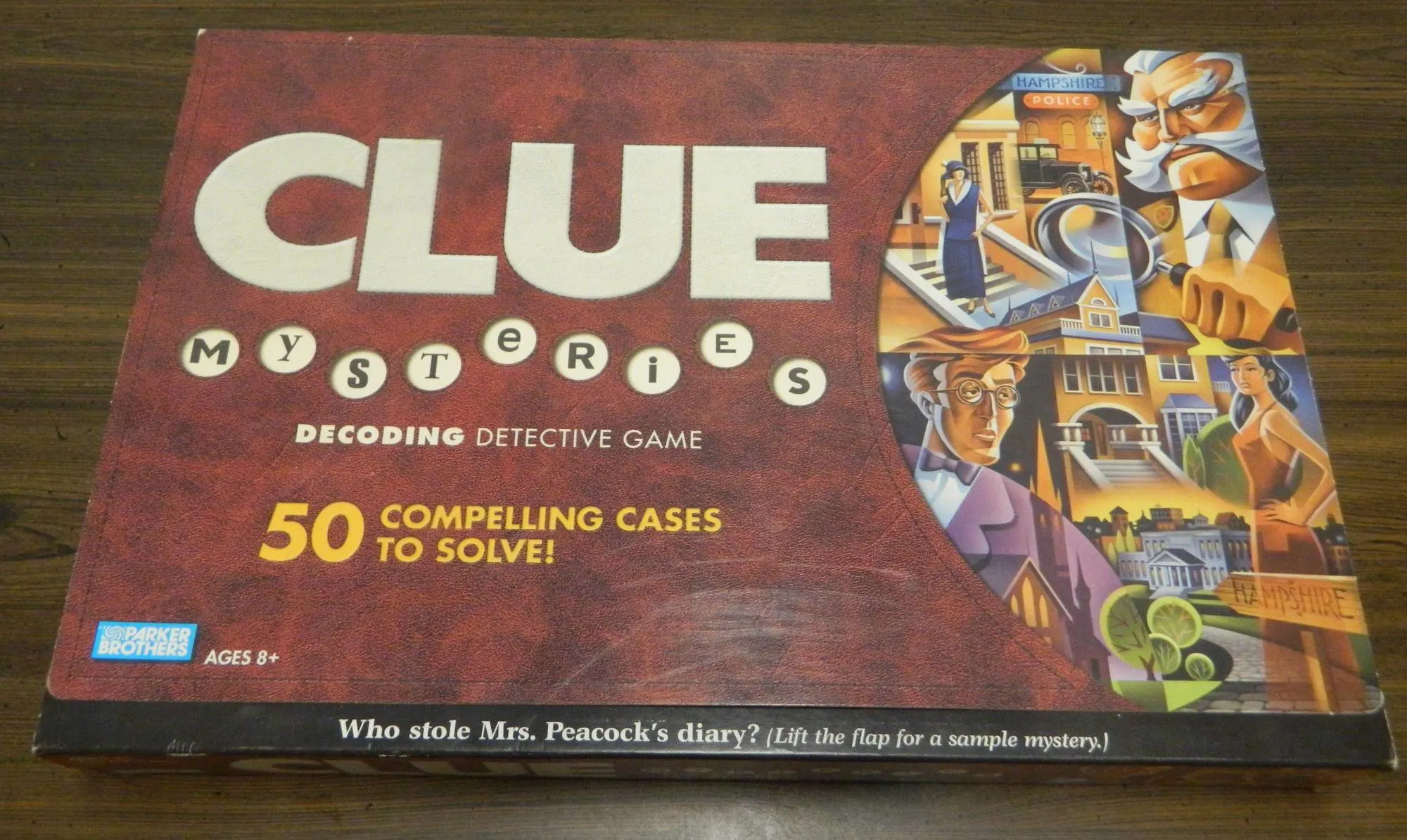
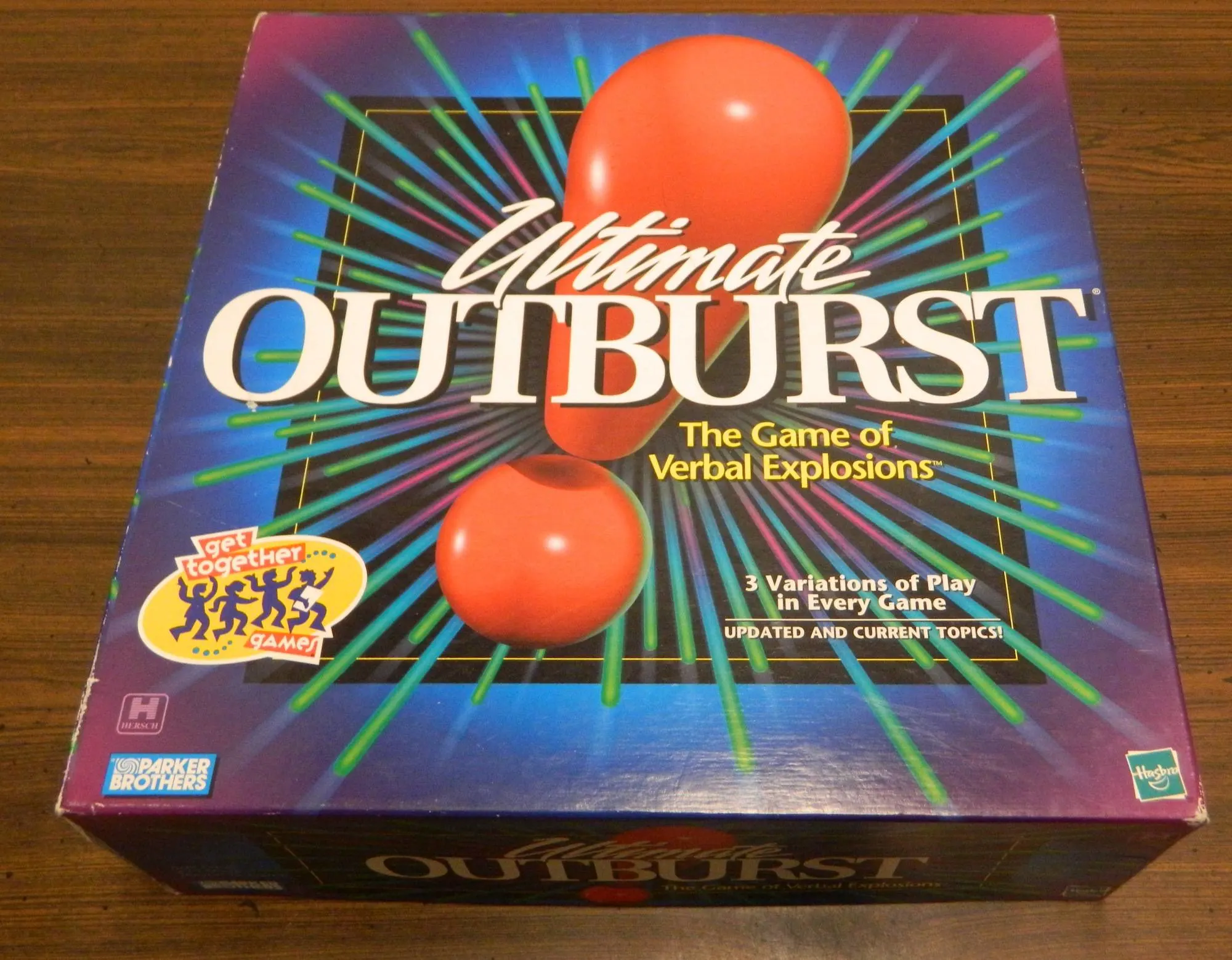
Rhiannon
Tuesday 7th of March 2023
Payday is a fundamentally "nice" game with very little conflict. It's rare that players take money away from each other, and at most it's $600 at a time. It's almost impossible to lose money, even by intent (buy deals, never cash in on buyers, yet you STILL won't get that many bills every month). Even when a player finishes last, they don't feel beaten down (unlike the worst board game ever, Monopoly).
It may be a mediocre game for native English speakers, but I teach ESL (English as a Second Language) in an Asian country. Schools want me to play Life with them, which is FAR too complex even for older kids who speak well. Payday is perfect for basic math skills (including teaching interest), reading "mail" (seeing if they can get the in-jokes), and teaching everyday things and vocabulary like days of the week. Even those with minimal English skills can figure out the game, yet older kids still have fun with it. And I can set a time limit for play (i.e. how many months) to match the available class time.
The only bad thing about it is it comes with four pawns for four players, but that's easily fixed.